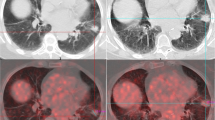Abstract
The discovery of exogenous particles in the broncho-pulmonary tree is frequently described in forensic literature, especially in lung samples, in the context of aspirated gastric content during the death agony period or during resuscitation. We report an original observation of a multi-visceral dispersion of exogenous particles detected, in an 8-year-old boy, who allegedly fell from a 2-m high brick-wall. The autopsy found major liver fracture and diaphragm rupture with massive internal hemorrhage without gastric wall rupture. The histological analyses have identified round to oval bodies in the lung bronchi, alveoli, and, rarely, in vascular sections, and also on the surface of several samples. These particles stained strongly pink by the periodic acid Schiff method, evoking dried vegetables. Two hypotheses were invoked: aspirated vegetable particles into the bronchial tree or parasitic infection, like pinworm larva. In order to characterize the nature of these particles, different legumes were cooked, embedded in paraffin wax, and examined under light microscope. Simultaneously, morphological comparison between the gastric content and pinworm larva and lentils was made and a PCR analysis was performed on gastric fluid sample. The DNA sequencing showed a Fabaceae plant family, Lens culinaris. The possibility of a hematogenous dissemination of the starch grains during a perimortem aspiration of gastric content seems unlikely, and a contamination from the gastric content of the organs samples during the autopsy or the pathologic macroscopic and microscopic processes seems to be the principal hypothesis. The formal identification of such particles is important to avoid the misdiagnosis of a potential parasitic infection. The risk of confusion can be detrimental in some circumstances.




Similar content being viewed by others
References
Charlier P, Huynh-Charlier I, Brun L (2014) Broncho-pulmonary aspiration of brain and cartilage tissue in a context of gasping. Ann Pathol 34(6):474–476. https://doi.org/10.1016/j.annpat.2014.09.005
Crome L, Valentine JC (1962) Pulmonary nodular granulomatosis caused by inhaled vegetable particles. J Clin Pathol 15:21–25. https://doi.org/10.1136/jcp.15.1.21
Knight BH (1975) The significance of the postmortem discovery of gastric contents in the air passages. Forensic Sci 6(3):229–234. https://doi.org/10.1016/0300-9432(75)90014-x
Knoblich R (1969) Pulmonary granulomatosis caused by vegetable particles. So-called lentil pulse pneumonia. Am Rev Respir Dis 99(3):380–389
Head MA (1956) Foreign body reaction to inhalation of lentil soup: giant cell pneumonia. J Clin Pathol 9(4):295–299. https://doi.org/10.1136/jcp.9.4.295
Anderson IC, Cairney JW (2004) Diversity and ecology of soil fungal communities: increased understanding through the application of molecular techniques. Environ Microbiol 6(8):769–779. https://doi.org/10.1111/j.1462-2920.2004.00675.x
Mitchell RJ, Zuccaro A (2006) Sequence: the environment and fungi. Mycologist 20:62–74. https://doi.org/10.1016/j.mycol.2005.11.004
Alvarez E, Garcia-Hermoso D, Sutton DA, Cano JF, Stchigel AM, Hoinard D, Fothergill AW, Rinaldi MG, Dromer F, Guarro J (2010) Molecular phylogeny and proposal of two new species of the emerging pathogenic fungus Saksenaea. J Clin Microbiol 48(12):4410–4416. https://doi.org/10.1128/JCM.01646-10
Kradin RL (2017) Diagnostic pathology of infectious disease, 2nd edn. Elsevier, Philadelphia
Farrugia A, Ludes B (2011) Diagnostic of drowning in forensic medicine. In: D V (ed) forensic medicine from old problems to new challenges, 1st edn. Intech, Rijeka, pp 53–60
Zhang P, Kang X, Zhang S, Xiao C, Ma Y, Shi H, Xu Q, Zhao J, Chen L, Liu C (2019) The length and width of diatoms in drowning cases as the evidence of diatoms penetrating the alveoli-capillary barrier. Int J Legal Med 134:1037–1042. https://doi.org/10.1007/s00414-019-02164-4
Author information
Authors and Affiliations
Corresponding author
Ethics declarations
Conflict of interest
The authors declare that they have no conflict of interest.
Additional information
Publisher’s note
Springer Nature remains neutral with regard to jurisdictional claims in published maps and institutional affiliations.
Rights and permissions
About this article
Cite this article
Oertel, L., Gressel, A., Tortel, MC. et al. Be careful with lentils! About a forensic observation. Int J Legal Med 135, 323–327 (2021). https://doi.org/10.1007/s00414-020-02389-8
Received:
Accepted:
Published:
Issue Date:
DOI: https://doi.org/10.1007/s00414-020-02389-8




